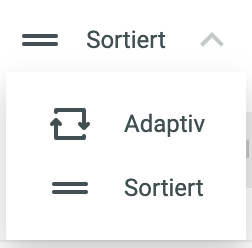Structuring of learning content
Learning videos, web-based trainings, webinars or trainings: the content in each of these units has been put into an order that makes sense from her/his point of view by a trainer or author. In the best case, this is preceded by a definition of the learning objectives: What should the participants have learned after the measure?
Once the learning objectives are available, the learning time and format must be defined. Both aspects are cost drivers, so decisions are not made solely according to didactic parameters, but also according to economic ones.
Now we finally come to the structuring of the content: How do you give the participants the necessary context? Do you first describe a topic on an abstract level and then give an example, or vice versa? When are good times for exercises and discussions? As you can see, it is not possible to describe a one-size-fits-all approach, as all factors have to be taken into account: Learning objectives, formats, premises, time, budget, the type of content, its complexity, etc.
Experienced didacticians have already noticed which factor we have not yet listed: The participants.
Participants:inside are the most heterogeneous factor
As if it were not complicated enough, we develop our learning activities for a varying number of individual participants. Some learn best inductively, that is, first by concrete examples and then by theory. For others it’s the other way around, they want to understand the theory before they get to the examples.
Participants bring different levels of prior knowledge with them. While some first have to carefully understand the context and gain basic knowledge, others are already ten steps further and are impatiently waiting for the content that is exciting for them to finally follow.
In addition, there are other factors, such as the communication between the participants, the speed of learning or hierarchical behaviors that require different approaches.
In classroom trainings and webinars there are usually between 5 and 30 participants. But learning videos and web-based trainings are often created for several thousand participants. That’s why we developed chunkx to enable adaptive learning automatically and without any effort on the part of the author – whether for five or several thousand users.
Learning in chunkx – this is how it works
In chunkx, content is broken down into learning tasks as the smallest possible interactive formats. Learning tasks have the advantage that they not only stimulate memory, association and learning processes, but also make productive use of the user’s time: If I can already do something, it will only take me a few seconds to complete it. If I can’t do something yet, I deal with it more intensively. The tasks always contain all the necessary learning content, integrate images and videos, or refer in the feedback to sources that describe the content in even more detail – such as a web-based training or a blog article.

The learning tasks are also supplemented by a timeline on which users can receive pre-programmed or manually sent messages from authors. In turn, they learn how many users have responded to their posts and what is more and less interesting to them.
By combining a micro-learning format with data that reflects the interests and knowledge of users, our algorithm creates individual learning paths across any number of topics. Quite automatically and without complex programming, the strengths of the users are given less priority than the weaknesses and learning content is continuously repeated according to the respective user difficulty.
Sorting instead of adaptive allocation
Let’s imagine a channel with 40 learning tasks. Adaptive allocation means that task #39 is shown first to one user, task #1 to another, or task #20 to yet another user. In order to provide users with a fixed order, authors can change the channel in chunkx from adaptive to sorted at any time. As a result, new content from the channel is presented in exactly the order the author deems most appropriate. The emphasis here is on “new” content. Because repetitions are always used in chunkx according to. of the learner’s individual data, i.e., adaptively assigned.
Adaptive vs. sorted – which is the better choice when?

Adaptive
Let’s think back to the complexity of sorting learning content described at the beginning. Here, chunkx offers authors the chance to exploit the possibilities of digital solutions and to rely on the support of our algorithm when it comes to the user-specific selection of learning content. In the following scenarios, this makes especially much sense:
1. supplementation of learning measures
With chunkx, trainings, webinars, webbased trainings can be easily extended. When the above measures end, content can be repeated and reinforced via chunkx. And since repetitions should be based on the individual level of knowledge and not on a fixed order that applies to everyone, the “adaptive” setting is the best choice here.
2. many equivalent contents
Sometimes topics consist of many knowledge units that do not so much build on each other, but stand neutrally next to each other. This can be the case of legal and regulatory content, but also when you want learners to apply learned knowledge to new contexts through a variety of application scenarios. Here, too, we believe that the “adaptive” setting is the best way to efficiently present users with the content that is relevant to them.
3. particularly heterogeneous target groups
The larger and more diverse the target users are, the more difficult it is to define a successful fixed sequence of learning content. Of course, it is also possible to prepare channels for different target groups differently in chunkx – e.g. a separate variant only for executives – but even after such a division, the participants are still too different, then a content selection makes sense according to the “chunkx” concept. We write “possibly” deliberately, because here the advantages described below for the “sorted” setting must be weighed carefully against those described above.
Sorted
The “sorted” setting offers authors other possibilities and advantages, especially in the following situations:
1. new contents
If chunkx is not used subsequently to another measure, but presents content as a learning unit to users for the first time, a predefined structure of the content is suitable. In this case, too, the learning time of the individual user:s is used more productively than in other learning formats, because familiar content costs them little time and unfamiliar content is repeated selectively. The fixed sorting applies only to “new” content that users have not yet edited.
2. strong narrative
At its best, learning content should inspire and engage us. And we believe that you can do this even with the most supposedly boring topic. In adaptive micro-learning, we face the particular challenge of ensuring that we chop up content as much as possible so that we can, in turn, arrange it in a flexible and user-specific way. However, this also means that successful scenarios, pictorial descriptions, emotionalizing narratives can only be built up within a single micro-unit, since we do not know for sure what users have already processed and what not. Sorting learning content can overcome this hurdle. You can now be sure that the thread within the topic is maintained and you know exactly that all user:in step by step through the same texts, images, videos and exercises wander.
Sorted vs. adaptive – the authors decide
In our authoring tool chunkx creator, authors decide which setting suits their channel. Helpful tips help with the selection and it is also possible to change the setting again after go-live: If a channel is put online with the setting “adaptive” and you realize after a short time that a sorting would be more suitable after all, this can be adjusted immediately. The order of the content can also be changed and readjusted at any time.
Are you looking for advice on setting up and structuring your continuing education projects or interested in chunkx? Feel free to contact us free of charge and without obligation.
Read our blog article Tagging at the touch of a button to learn how we use tags to adaptively recommend and select content for users across channels.







